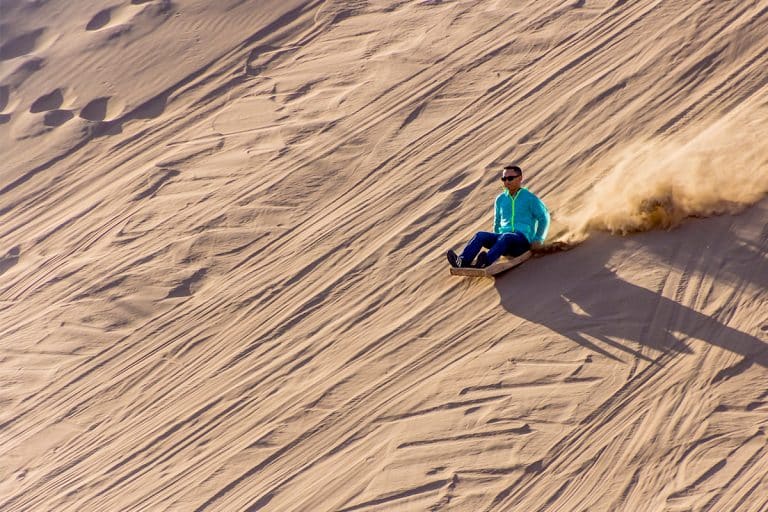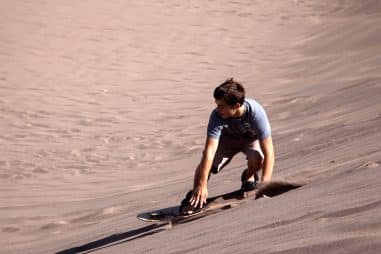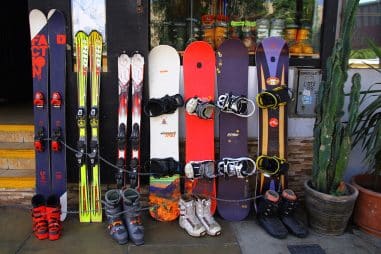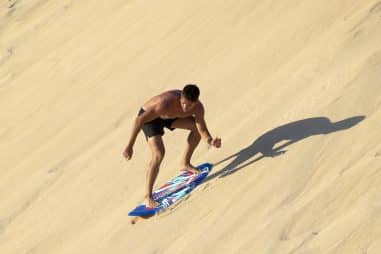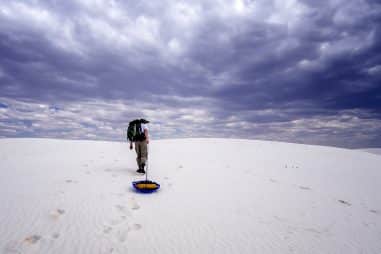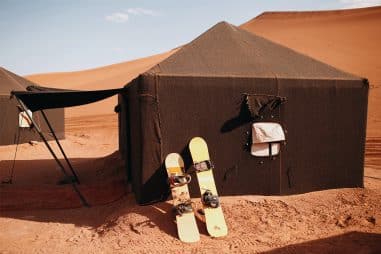Sand sledding is one thrilling sport that can be performed in glistening desert dunes. This activity is best partnered with a breathtaking sunrise or an evening of stargazing. Sand sledding can be enjoyed by adults as well as kids as a recreation. There are also a considerable number of destinations you can hit to sand sled all around the world and enjoy the beauty of the dunes.
Can You Sled Down a Sand Dune?
While it is possible to sled on the sand, you must also consider that sand sledding is fairly different and difficult than snow sledding. For starters, there is a specific sand sled that you can use and is usable on the sand.
You must also consider safety as sliding on wet dunes is discouraged as being too dangerous. Take into account the season as this will also affect the weather. For example, during the spring and fall seasons, the temperature is just right the whole day, but during the summer season, it can get very hot so it’s best to sled in the early morning or evening.
What Is a Sand Sled?
A sand sled is a board, with a size of around 100cm – 150cm (around 40 – 60 inches) long. Typically, sand sleds are composed of the same materials used to make sandboards, a mix of laminate and hardwood. Sleds are usually waxed so they can slide easily.
Wax is used to make the board sleek and slippery enough to be used properly. They also come in different sizes. You also need to check the type of sandboard you have because you might need to wax the base surface of your sandboard for without it you may not slide an inch or you may choose a “super race base” which requires a little or no wax at all.
What Can I Use for Sand Sledding?
Alternative to sand sleds, you can also use a toboggan or disc saucer. Plastic toboggans are used mostly on artificial hills or smaller dunes. Though they are usually made for snow, they can also be used on the sand with proper waxing.
Disc saucers or saucers are mostly used by children. They can come in a plastic or steel material, the latter is more durable than the former. Younger people tend to enjoy saucers more as they can sit and maneuver the saucer while sledding. Like with toboggans, they require thorough waxing to function well.
Can You Use Snow Sleds on Sand?
Unfortunately, you cannot use snow sleds on dunes. Snow sleds have rails and they will only stall. Unlike snow, sand is not slick that’s why boards require waxing.
It is still best to buy sleds specifically for sand or rent if you are looking for a more affordable option. Sled rental charges around $20 per day depending on the location which is a fault affordable price.
How Do You Make a Sand Sled?
Seeing as sand sleds can get pricey, you might find yourself DIY-ing your very own sand sled. With a lot of patience, you can save a lot of money by making your own sled.
Here are the materials you’ll need:
- Plywood
- Plastic barrel
- Rope
- Stainless steel screws
- French curve
- Pencil
- Hand saw
- Heat gun
- Tape measure
Here are the steps in making a sand sled:
- Layout the rails. Cut 2 pieces of plywood with the measurement of 6 inches x 4 foot long.
- Using a French curve, Cut the sides of the plywood.
- For the back side of the plywood, get a tape measure and measure 6 inches for length and half an inch for width.
- Cut the plywood using a hand saw and use a sandpaper to clean the edges.
- Cut a 14 and a 1/2 x 6 inches of plywood for the back.
- Screw the plywood to attach all sides.
- Cut 3 pieces of 14 x 1 1/2 inches of plywood.
- Attach one at the bottom part where the curve is. It should be on the lowest part of the frame of the sled. Then attach two at the top part slightly apart to one another.
- Make holes at the sides for the ropes.
- Wax or varnish the frame.
- Cut a plastic barrel and use it as the floor of the sled.
- Attach the plastic barrel using screws.
- Take a heat gun and use it to attach to the frame.
- Attach the ropes.
- Put wax at the plastic barrel.
Note that there will be either a square or circular tail on sand sleds, and the two sides do not have to be asymmetrical. The board’s body needs to be broad enough to fit a human (or two), so strive for a width of at least 25cm. For adults, stick about 110cm longitudinally, 100cm for kids.
What Do You Wear to Sand Sledding?
Unlike other sports, there’s no official gear or equipment to wear or bring when sand sledding. Aside from the sled, you are going to use, equipment and accessories can vary from sledding locations.
- Clothing: Casual wear is fine; most people use long sleeve tops to protect themselves from the heat while some go bare chest.
- Footwear: Like clothing, you can opt to not wear anything and go barefoot but if you do decide to wear shoes, choose sturdy shoes. Most people use running or hiking shoes as you will need to protect your feet on the dunes.
- Goggles: It’s always a good idea to wear goggles when sand sledding. Aside from protecting your eyes from the sun, it also helps to avoid sand getting in your eyes—two birds with one stone.
- Mouth scarf: This covers and protects the lower half of your face, comprising of the nose and mouth.
- Knee and Elbow Pads: Not required but definitely welcome as an extra layer of protection. Padding can help protect from sand surfaces that get too hot.
- Helmet: Choose a lightweight and breathable helmet to make the most out of your sand sledding adventure!

